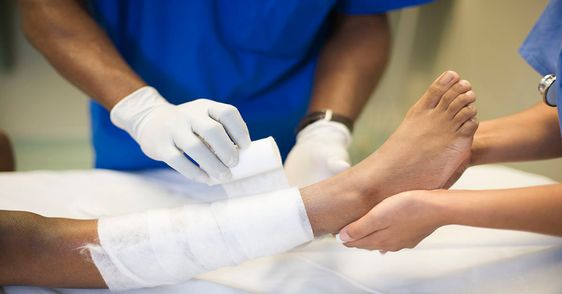Periwound skin management refers to the cleansing, protection, and treatment of the skin around a wound to promote wound healing and prevent infection. Below we describe the basic principles and methods of peri-wound skin management.
Basics on managing periwound skin:
The periwound area, defined as the area within 4 cm of the wound edge, is critical for wound healing and recovery. Even if the wound itself is in good condition, damage to the periwound can adversely affect wound healing. Therefore, when performing wound management, careful assessment and management of the periwound are required.
Typically, there are three things that can happen around a wound: damaged, too moist, or inflamed. Damage can be caused by things like trauma, excessive moisture can be caused by wound exudate, and inflammation can be caused by irritation of the adhesive, an allergic reaction, or inflammation of the wound itself. These conditions can cause the skin around the wound to break down, or even new open areas to appear due to irritation, which can affect the healing and recovery of the wound.
Therefore, when choosing a dressing, you need to choose a dressing that can adhere but will not cause trauma, for example, Silicone Foam Dressing, this dressing will not cause secondary damage to the skin, especially for the already fragile skin, at the same time, The wound area needs to be cleaned, protected and treated to avoid infection and aggravated pain. Wounds that are too wet can be treated with an absorbent dressing to keep the area dry. For inflamed wounds, anti-inflammatory ointments and other drugs can be used for treatment.
How to treat the skin around the wound:
1. Clean the skin around the wound: Cleaning the skin around the wound is one of the important links in wound management. Cleaning should be done by gently washing the skin around the wound with warm water and soap. After cleaning, it needs to be dried gently with a clean towel or gauze.
2. Protect the skin around the wound: The skin around the wound needs to be protected to avoid infection and aggravate the pain. Appropriate wound dressings may be used. For larger periwound skin, special dressings, such as transparent dressings, can be used.
3. Treatment of periwound skin: For damaged periwound skin, proper treatment is required. Topical medications such as ointments and sprays can be used for treatment. Surgical treatment, such as suturing, is required for deeper skin injuries around wounds.
4. Prevention of complications: During the management of the skin around the wound, attention should be paid to prevent the occurrence of complications, such as infection and scars. It can be prevented by using antibiotics, scar repair drugs, etc.
5. Pay attention to nutrition and water intake: the health and healing of the skin around the wound requires adequate nutrition and water support. Patients should pay attention to a balanced diet and drink plenty of water to promote wound healing and recovery.
During treatment, cleaning, protection, treatment, and prevention of complications are required. Through scientific and reasonable management methods, it can effectively promote the healing and recovery of the skin around the wound.
For more information on Innomed®Hydrocolloid Dressing, Refer to the Previous Articles. If you have customized needs, you are welcome to contact us; You Wholeheartedly. At longterm medical, we transform this data by Innovating and Developing Products that Make Life Life easier for those who need loving care.
Editor: kiki Jia
Date: August 15, 2023

 English
English عربى
عربى Español
Español русский
русский 中文简体
中文简体








